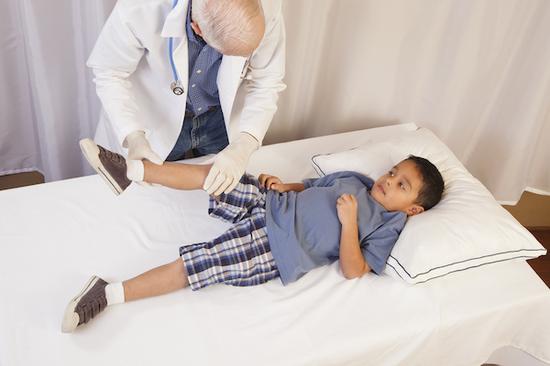Sometimes in life, children talk to their parents about leg pain and strange walking posture. Many parents don't care that it is growth pain, but if children have leg pain repeatedly, is it pure growth pain?
Xiaohuang is a boy aged 12 years and 2 months. He suffered from pain in his right foot and left heel after activities. His parents thought that the injury was caused by activities, but they did not pay special attention to it after the hospital gave symptomatic treatment. Later, his left eye showed redness, swelling and photophobia, indicating iridocyclitis. After repeated treatment, no obvious improvement was seen. Finally, we went to the outpatient department of the Rheumatology Department of our hospital for treatment, and after a series of related examinations were carried out in hospital, the final diagnosis was: juvenile idiopathic arthritis (arthritis associated with attachment point inflammation), iridocyclitis.
Xiao Zhou is a 12-year-old girl. When she was admitted to the hospital, she had persistent high fever, red rash all over the body, itching, bilateral ankle pain, hepatomegaly, improved various examinations, excluded infection, blood system tumors, other autoimmune diseases, and finally diagnosed as juvenile idiopathic arthritis (systemic type), macrophage activation syndrome.
Then, you may be very curious about what exactly is the "juvenile idiopathic arthritis" mentioned above? You may be familiar with it by another name. In adults, we are also called rheumatoid arthritis.
Juvenile idiopathic arthritis refers to: single or multiple arthritis that starts before the age of 16 and lasts for 6 weeks or more (arthritis is defined as joint swelling/effusion, or there are two or more of the following signs: 1. Restricted movement; 2. Joint tenderness; 3. Pain during joint movement; 4. Increased skin temperature on the joint surface, and other diseases are excluded).
The incidence of juvenile idiopathic arthritis in children is about 0.01% - 0.1%, and the disability rate is high. For untreated children, the disability rate is 50% in two years and 70% in three years. However, if timely and effective treatment is carried out, clinical symptoms are controlled, joint function is maintained and joint deformity is prevented, at least 75% of children will be free from disability.
It is an autoimmune disease, because the immune system partially loses the ability to distinguish "foreign" and "own" cells, thus destroying its own joint components. Juvenile idiopathic arthritis is not a genetic disease, because it is not directly transmitted from parents to their children. However, there are some genetic factors that lead to susceptibility to the disease, and then the joint action of external environmental factors leads to the occurrence of this disease.
Juvenile idiopathic arthritis is a chronic disease. Clinically, it is characterized by persistent arthritis. The typical manifestations of arthritis are pain, swelling and limited movement. Its characteristic manifestation is joint stiffness, which occurs after a long rest. Therefore, it is easy to appear (morning stiffness), especially in the morning.
From the above two cases, we can see that the onset of arthritis presents a variety of symptoms, including joint swelling and pain, eye inflammation, fever, rash, and arthralgia. In fact, according to different clinical manifestations, juvenile idiopathic arthritis can be divided into 7 different types.
Their main differences are: whether there are systemic symptoms and the number of involved joints, that is, systemic juvenile idiopathic arthritis; The polyarticular juvenile idiopathic arthritis can be divided into two types: RF negative and RF positive; Oligoarthritic juvenile idiopathic arthritis; Psoriatic arthritis; Arthritis associated with attachment point and arthritis with undetermined classification.
Routine examination of juvenile idiopathic arthritis includes: routine blood test+CRP, erythrocyte sedimentation rate, ferritin, RF, HLA-B27, cytokines and other inflammatory indicators, joint MRI, eye examination, and some examinations excluding tumors, tuberculosis, and other autoimmune diseases.
Juvenile idiopathic arthritis should be diagnosed and treated in a timely manner. As suggested by the above two cases, once a child is found to have joint tenderness, swelling, limited activity or typical eye manifestations, he must go to the Children's Rheumatology Department for timely diagnosis and treatment. Because if juvenile idiopathic arthritis is not treated in a timely and effective manner, joints will be damaged, even life threatening, and eventually lead to joint deformity and even disability.
Niu Xiaoling, Dong Yanfei, Huang Wenyan/Rheumatology and Immunology Department of Shanghai Children's Hospital
Related links:
Hot registration: Sina 2017 Early Childhood Education Summit Forum
Hot registration: Sina 2017 Baby Industry Ceremony
Award winning survey: 2017 China Maternal and Infant Consumption Survey
Award winning survey: the best choice for parents - the survey of Sina Early Childhood Education Research Institute
Award winning survey: survey on user behavior in China's maternal and infant industry
Activity: China Mothers and Babies We Media Award is in progress











